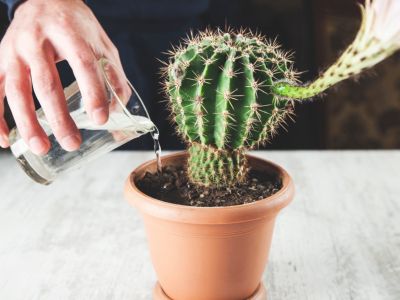How Often Do You Need to Water Cactus?
Cactus plants are actually quite juicy. Think of an aloe when you cut it open and the mucilaginous goo that is inside the leaves. Cactus plants actually hoard moisture in their plant cells so they have some water during extremely dry, drought-like conditions. They are remarkably tolerant to water neglect but certain signs in the leaves, pads, or stems will indicate that the plant is becoming stressed due to a lack of moisture. Recognizing these signs, along with some education on your plant’s native region and climate, can help indicate the best time for watering cactus plants. There are many factors influencing the timing of watering cactus plants. Are the plants in ground or in containers? What is the lighting exposure, air temperature, soil type, size of plant, wind or draft exposure, and time of year? No matter the time of year, one constant among any type of cactus is its inability to tolerate standing water. To this end, soil type is very important. Loose, well-draining soil is essential to cactus health. If the soil is porous enough, occasionally overwatering is not much of an issue, as excess will easily drain away. Heavy, compact clay soils or those with heavy amounts of organic material tend to capture water and can cause rot in cactus roots and lower stems. Plants in full sun tend to dry out more than those in lower light conditions, as do windy or drafty sites.
Cactus Plant Watering
Cactus plants tend to do the majority of their growth in the warmer seasons. This is when they need supplemental moisture to fuel that growth. Spring and summer plants need to be irrigated enough to avoid wrinkled leaves, pads, and stems, and to promote new cell production, flowering, and fruiting if applicable. In late fall and winter, plants are in their resting state and need just enough water to get them through the season. During this period, potting soil or in-ground soil should be allowed to dry out between watering. However, plants located near the hot dry air of a furnace or in full sun will dry more quickly than those in other locations and may require a bit more moisture to withstand those arid conditions. In spring and summer, plants need more moisture and average cactus plant watering should take place once per week or more frequently. This is why well-draining soil is important because any extra moisture can move away from sensitive roots.
How to Water a Cactus
There are several schools of thought on how to water these plants, but one fact is clear. Don’t mist desert cactus. They are not native to regions where surface moisture and humidity is prevalent. Instead, they reach deep into soil to harvest moisture left over from the rainy season. Jungle cacti are a bit different and thrive with some misting. An example of this type of cactus is the Christmas cactus. In general, most cultivated cacti will be desert denizens, so watering overhead should be avoided. Potted plants can be set in a saucer of water to intake moisture through the roots. Remove the plant from the saucer after the soil is saturated halfway up. Another method of cactus plant watering is to simply apply it to the surface of the soil. In this case, several factors influence the amount of water such as heat, direct light, and planting situation. In general, a slow, deep watering is sufficient once per week. This may translate to soaking a container until moisture runs out the drainage holes or using a garden hose set low to steadily drip water to the root zone of the plant for several hours. Just remember, be sensible when watering cactus plants and find out what type you have and from whence they hail. This can make decisions on plant irrigation much easier.
